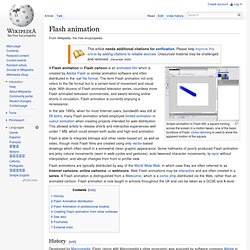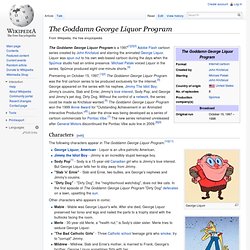

eben zboch
Wasbuxton. "Stop" Animation Using MIDI Controllers. Backpacks Infographic: How to Find the Right Backpack - REI. Need a break from the daily multitasking merry-go-round?

Trade in your digital devices for boots and backpacks—they're your ticket to off-the-grid adventures and the wonders of the backcountry! With the right pack and a little preparation, you can head out for a day hike or a through-hike and say "CUL8R" to the daily grind. Add this infographic to your website by copying the code below: <p><a href=" src=" alt="Backpacks Infographic: How to Find the Right Backpack for You" title="Backpacks Infographic: How to Find the Right Backpack for You" /></a><br /><br />Check out REI's <a href=" next time you head outdoors! </p> An Historical Timeline of Computer Graphics and Animation. Robert Able & Associates produces the 1st computer generated 30 second commercial used for Super Bowl (Brilliance) Wavefront Technologies is the first commercially available 3D software package (founded by Mark Sylvester, Larry Barels and Bill Kovacs ) Thomson Digital Image (TDI) founded Jim Clark receives the 1984 ACM SIGGRAPH CG Achievement Award International Resource Development report predicts the extinction of the keyboard in the next decade A-buffer (or alpha-buffer) introduced by Carpenter of Lucasfilm Distributed ray tracing introduced by Lucasfilm (Ref: Cook, Robert L., Thomas Porter and Loren Carpenter.

Cook shading model (Lucasfilm) (Ref: Cook, Robert L. 14.5 minute computer generated IMAX film (The Magic Egg) shown at SIGGRAPH 84 - 18 teams; 20 segments Universal Studios opens CG department First Macintosh computer is sold; introduced with Clio award winning commercial 1984 during Super Bowl. Untitled Document. John Whitney, Sr. was one of the earlist and most influential of the computer animation pioneers.

He came at the problem from the background of film, working with his brother James Whitney on a series of experimental films in the 40s and 50s. His work in this area gave him the opportunity to collaborate with well known Hollywood filmmakers, including Saul Bass. His earliest computer work used analog devices for controlling images and cameras. After the second world war, Whitney purchased surplus military equipment and modified it to be used in his art making. Internet Culture. Jahanrn. ID 797 - History of Computer Graphics and Animation. The study of the history of CGI (computer generated imagery) is an important part of our overall educational experience, not necessarily to build on the historical precedent, but to gain an understanding of the evolution of our discipline and to gain a respect for the key developments that have brought us to where we are.

The discipline is so recent in its early developments and so rapidly changing that we are in fact living it, and it evolves as we speak. Yet we have been so busy in advancing the discipline that we have often neglected to accurately record this history. So we will decide to agree upon certain past events in order to begin to develop a definitive record of what has transpired in this evolutionary process.
We must learn from the past, as we develop a theory and methodology which is tuned to the capabilities and qualities inherent in software, hardware, animation techniques, etc. that are part of our broad, contemporary, and creative computer graphics environment. Flash animation. Simple animation in Flash MX; a square moving across the screen in a motion tween, one of the basic functions of Flash.

Onion skinning is used to show the apparent motion of the square. A Flash animation or Flash cartoon is an animated film which is created by Adobe Flash or similar animation software and often distributed in the .swf file format. The term Flash animation not only refers to the file format but to a certain kind of movement and visual style. With dozens of Flash animated television series, countless more Flash animated television commercials, and award-winning online shorts in circulation, Flash animation is currently enjoying a renaissance.
In the late 1990s, when for most Internet users, bandwidth was still at 56 kbit/s, many Flash animation artists employed limited animation or cutout animation when creating projects intended for web distribution. History[edit] Timeline of computer animation in film and television. Computer animation. An example of computer animation which is produced in the "motion capture" technique Computer animation or CGI animation is the process used for generating animated images by using computer graphics.

The more general term computer-generated imagery encompasses both static scenes and dynamic images, while computer animation only refers to moving images. Modern computer animation usually uses 3D computer graphics, although 2D computer graphics are still used for stylistic, low bandwidth, and faster real-time renderings. Sometimes the target of the animation is the computer itself, but sometimes the target is another medium, such as film.
To create the illusion of movement, an image is displayed on the computer monitor and repeatedly replaced by a new image that is similar to it, but advanced slightly in time (usually at a rate of 24 or 30 frames/second). For 3D animations, all frames must be rendered after modeling is complete. A simple example[edit] The Goddamn George Liquor Program. Premiering on October 15, 1997,[1][2] The Goddamn George Liquor Program was the first cartoon series to be produced exclusively for the internet.[5] George appeared on the series with his nephew, Jimmy The Idiot Boy; Jimmy's cousins, Slab and Ernie; Jimmy's love interest, Sody Pop; and George and Jimmy's pet dog, Dirty Dog.

Without the control of a network, the series could be made as Kricfalusi wanted.[5] The Goddamn George Liquor Program won the 1999 Annie Award for "Outstanding Achievement in an Animated Interactive Production. "[6] Later the show was being developed as a series of cartoon commercials for Pontiac Vibe.[7] The new series remained unreleased after General Motors discontinued the Pontiac Vibe auto line in 2009.[8][9] Characters[edit] Index of /spumco. New York Institute of Technology Computer Graphics Lab. The Computer Graphics Lab was a computer lab located at the New York Institute of Technology (NYIT) back in the late 1970s.

It was originally located at the "pink building" on the NYIT campus. It was linked to Computer Graphics Laboratory Inc. Many of the original CGL team now forms the elite of the CG and computer world with members going on to Silicon Graphics, Microsoft, Cisco, NVIDIA and others, including Pixar President Ed Catmull, Pixar co-founder and Microsoft Graphics Fellow Alvy Ray Smith, Pixar co-founder Ralph Guggenheim, Walt Disney Feature Animation Chief Scientist Lance Williams, DreamWorks Animator Hank Grebe, Netscape and Silicon Graphics founder Jim Clark (James H. Clark), Microsoft Graphics Fellow Jim Blinn, Thad Beier, Oscar- and Bafta nominee Jacques Stroweis, Andrew Glassner and Tom Brigham. Systems programmer Bruce Perens went on to co-found the Open Source initiative.